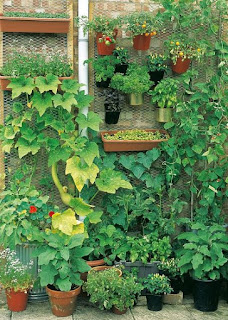How to Make Terrace Vegetable Garden
Make a Terrace Vegetable Garden on your rooftop, it is easy if you’ll do this with some planning. In this article you’ll learn which vegetables are suitable and how you can grow them on terrace.
Fresh home grown vegetables taste delicious, are good for health and safe from chemicals. You don’t need to acquire a regular garden to grow them, you can also grow these on a balcony or terrace.
There are some really interesting ways to incorporate the vegetable crops on the terrace. These alternatives are space saving and also a real eye-catcher.
1. Creating a vegetable Garden in Pots
In containers you can plant almost any vegetable. Choose large and deep pots, avoid thin and poor quality plastic pots because they heat up quickly and drain poorly.
Soil
Using normal garden soil is a bad idea for growing vegetables in pots. Instead use good quality potting mix for healthy growth of plants and productivity. You can also prepare it yourself.
Vegetables for Pots
Tomatoes
Cucumbers
Radishes
Beans
Potatoes
Onions
Carrots
Beetroot
Lettuce
Garlic
Chilies and Peppers
Gourds
Eggplant (Brinjal)
2. Create Raised Beds on Terrace
If you’re looking for practical as well as stylish way to make a terrace vegetable garden. Make a raised bed, in raised beds you’ll be able to grow lot of vegetables in compare to containers. Plants will thrive better with less care and maintenance, plus they are cheap.
The raised bed on the terrace does not differ fundamentally from those you see in a regular garden.
In well-stocked hardware stores or even online shops you will find special raised beds for terraces, you’ll only need to configure which one is better for you or you can make your own raised bed, which is very easy. Just ensure before installing it that the surface of terrace below it is waterproofed efficiently or not.
Fill Raised Bed with Soil
If you fill the raised bed with soil, consider to prevent voles and pests from entering the bed.
To make soil, just mix quality garden soil, ripe compost and manure.
Advantage of Raised Beds
Probably the greatest advantage of raised bed is of course its height and wideness on terrace. Gardening can hardly be more convenient.
3. Integrate Vegetable Patch on the Terraceterraced vegetable garden
You can also integrate a vegetable patch on your terrace and grow vegetable on the surface itself. But doing this is only good on large rooftops. Vegetable patch is similar to making a normal garden bed.
The integrated bed should be filled normally with soil like a regular garden bed. An addition of compost in soil is a perfect natural fertilizer for most of the plants.
4. Creating a Vegetable Terrace Garden in Planter boxes
Flower boxes and planters can be used to create a vegetable garden. You can hang these on an existing railing or set them just on the floor. How do you use them is entirely up to you.
Do not use ordinary garden soil in these planter boxes, either use quality potting mix or compost rich soil. Fertilizing is also important to improve productivity but it varies according to plants: peppers and tomatoes are heavy feeders, whereas green leafy vegetables do not need much fertilizer.
Plants for Flower Boxes
Cucumbers
Tomatoes
Garlic
Chilies
Herbs
Radishes
Bush beans
Greens
Cucumbers, tomatoes and beans require a climbing aid, so that the plants do not break.
5. Repurpose Sandboxes
A sandbox is not just for games. From a small simple wooden sandpit, you can also make a hefty vegetable patch. This looks not only decorative, but provides your plants an optimal space to thrive.
Instead of using gravel for drainage, just fill the quality compost with soil. In the sandbox you can grow all sorts of small vegetables and herbs, mostly low growing that spreads too much.
Radishes
Herbs
Garlic
Lettuce
Spinach
Ginger
Asian Greens and lot of other green leafy vegetables
6. Optimize Vertical Space
Your main challenge is how smartly you utilize your vertical space to double up the space you have on your terrace, make a plan on how you should do this, if you have walls, hang planters on it.
Grow vegetable shrubs and vines like beans, squashes, gourds and tall tomato varieties near the walls and railings. This way they’ll not only get support but also grow outside and upward and you’ll save a lot of your space.
Use old shelves, racks to keep pots and buy pot holders, put them around the corners.
On these you can grow herbs to improve the taste of salads and cuisines you’ll prepare, you can also grow lot of flowers to appease ornamental views.
Tips for the Prolific Terrace Vegetable Garden
Fertilize vegetables regularly with good quality organic fertilizer. With some research and experience you’ll be able to find out which type of fertilizer you should feed to specific vegetables.
Water plants regularly and deeply.
Check plants regularly for pests.
Prune vegetable plants to keep them in good shape and in healthy growth. Look out for suckers, especially in tomatoes and pinch them off immediately if found one.
For the vegetables, it is always good to grow them on the Southern or Western face, so the plants will have enough sun and can thrive easily. But too much sun is not good either. If you live in a warm tropical climate and the sun is too strong, it is advisable to provide afternoon shade to plants.
Whether the vegetables growing in raised beds or in a pot, a certain care is needed. By your experience you’ll find out how, why and what you should do to grow them successfully on a terrace vegetable garden.














